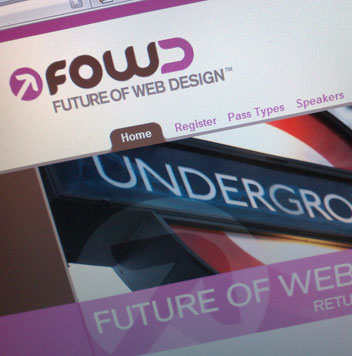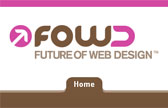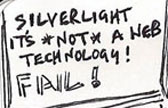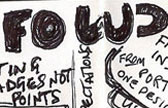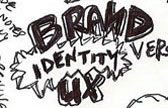2008 is the second year the Future of Web Design conference has been held. After coming away last year with inspiration and a renewed sense of enthusiasm for the Web, I decided to attend again this year – I also dragged my boss along to see what the fuss was about.
FOWD looks at current trends in web development and their association with other media, such as fine art, and tries to predict where the Web is going in the future. It’s a conference aimed at the web standards crowd, including both designers and developers – as a developer, I’m always inspired by great design, and this conference has some great examples.
Patrick McNeil from Design Meltdown presented “Finding Inspiration For Design” which talked about using inspiration from direct sources, such as fine art, billboards and commercials. Examples were shown which draw the user in to the website with cut-out style pictures that invade the user’s phyiscal space. Patrick also talked about current trends such as the colour brown and super-sized text. He briefly talked about potential future trends. He mentioned the use of pastel colours, which I agree with, but I don’t think horizontal-scrolling websites and video-heavy websites will be globally successful, but will work in some niche markets – especially in marketing and design portfolio websites.
Andy Clarke & Steve Pearce debated whether ‘User Experience’ and ‘Brand Experience’ had to be mutally exclusive. I didn’t really get much out of this segment and it didn’t seem very well polished. However, Steve’s slides were extremely cute and unique. Jeremy Keith sums up Steve’s presentation very well saying:
An experience iceberg. The visual part sits above the surface (what most people see) but the main part (that people interact with) is below the surface. We spend too long focusing on the bit above the surface. It doesn’t matter how much you polish the visible bit if it’s a wreck underneath. Basically, you can’t polish a turd …or a turdy iceberg. Instead we should work on the experience, which is the stuff under the surface. The reason we should work on this is that users will spread the word about good and bad experiences.
Andy Budd talked more about user experience with his presentation entitled “Designing the User Experience Curve”. Andy’s talk was an interesting insight in to the minds of users, and how they not only compare your website’s experience to other websites they’ve used, but also to real-world scenarios. Andy talked about the attention to detail, user feedback and making the experience fun. Users remember details and often mention them if they talk (promote) your product or service. Real-world examples include good concierge service and a Innocent Smoothie making you smile with the words “Stop looking at my bottom” on the underside of the carton. Moo, a printing company, has this attention to detail – they use quirky personalities in their automated emails – users remember good details and recommend such services, like I’ve just done!
Elliot Jay Stocks talked on “Print is the new web”, making comparisons between what is available for the print industry (white-space, unusual layouts and breaking grid systems) and what is limited on the web. Also comparing the different styles employed in Flash design to HTML/CSS and that each industry should beinfluenced by each other.
Jon Hicks, who doesn’t want to be famous for designing the Firefox logo, walked through building a basic website from scratch in to a workable template using HTML and CSS in his presentation “From Design to Deployment”. I felt this presentation was a little out of sync with the rest of the day, being more practical than design theory. However, I learned a couple of gems which I will now apply to my web development. A tip I’d like to pass on is: use both the full name and PostScript name of your fonts to make sure the font will work in both Safari and Firefox – Guillermo Esteves has more information about this.
Paul Farnell went through some of the “Unconventional ways to promote your site” with experience and examples from promoting his web application. This was the first time I’ve seen Paul speak and he communicated his ideas very well. Most of the tips can be applied to every website you build, and so this was a very useful presentation.
Daniel Burka who works on two large community-based websites, Digg and Pownce, presented “Evolving the User Experience”, continuing the theme of the day. Many of the things Daniel talked about, such as iteration and community feedback were very useful and insightful because of the community applications he works on. However, I do not think this was the correct target audience for this information as I doubt the majority of people have the traffic, scaling issues and community of these sites. This was an interesting talk but I felt nothing which was really of use for me.
Overall, like last year, although I didn’t necessarily learn a lot, I came away from the conference with a renewed passion for the Web, and couldn’t wait to get back to a computer and start tinkering with ideas which welled up throughout the day.
Going to conferences is a great way to rejuvenate interest and interact with enthusastic colleagues. I always come away with at least one new idea I think could work and this time was no exception.
